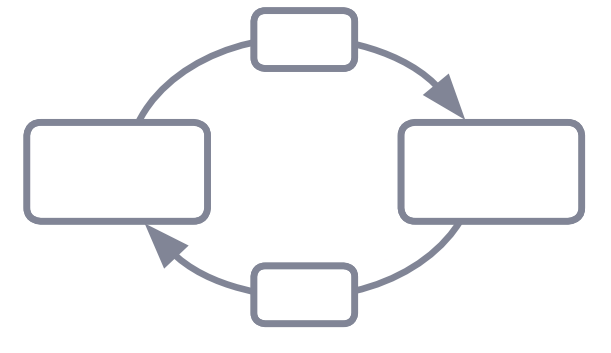Relationships (R) are not enough!
There are a number of folks in the systems thinking world who are of the opinion that when discussing what is universal to all attempts at thinking systemically, it all comes down to relationships. "Everything is interrelated" they'll say (which is neither actually nor technically the case). "Relationships are all you need," they'll say (also not accurate). "It's all just relationships between relationships," they'll advise (no, it's not). Let's take a deeper look at why relationships are not enough to make a claim of universality.
Saying that it all comes down to relationships is certainly seductive and attractive, but I propose that it also lacks meaningful specificity and is an oversimplification. Relationships are necessary but they alone lack sufficient detail of the many other things going on in systems and in systems thinking. Things such as:
- the nested, hierarchical, or tree organization that come about as a result of part-whole structure and lead to important dampening effects; or
- important biases that go into distinguishing any boundary (including relationships themselves); or
- the idea that all of these "patterns of interconnectedness" can look different from different perspectives (not only outside the system such as an observer but inside the system such as organisms in an ecological network).
A thought experiment
Before we rule it out, let's take a hypothetical walk through the challenges such a theory would face. Let's do a thought experiment and imagine that we came up with a universal theory of systems thinking and called it the relationships are universal theory or, RUT for short. Just to provide a clear example of what such an RUT theory would look like, visually RUT would consist of lines with arrows relating to lines with arrows, ad infinitum. Because if all there are are relationships, then that's all you get to use.

And while that may suffice for the quantum world, in this macro-scale world, structure exists (dissipative perhaps but structural nonetheless). That's RUT's first problem.
But the second problem RUT faces is much bigger in my opinion. The RUT theory does not account for boundaries! If our RUT is based solely on relationships between relationships then the problem is that the theory only allows for a single relationship (not even that, philosophically, but I'm trying to be generous), because you have no distinguishing function. Without the algorithm for drawing a boundary you can't say that this relationship is different from that relationship because there is no this or that. There are no distinctions in a RUT world. There is only oneness. Indeed, with RUT there is no oneness either, because you can't make any distinctions whatsoever (you can't even distinguish the oneness from the void). That's a huge problem if you can't distinguish anything from anything else. Visualizing it is also difficult, it would look like the empty space below where nothing is distinguished (I put a little shadowing in just so you could see it but that shadowing wouldn't be allowed in RUT).
Even if we could get past these two big problems in our RUT, it faces another shortcoming: Containment. All those indistinguishable relationships, as far as we can tell from everything in all systems sciences, ignores the problem of enclosure across scale. Scale matters. Things are contained by other things. Things are inside of other things. For this you need some function that produces part-whole or nested structure. The preponderance of network diagrams, for example, utilize nodes and edges in a flat-scale map. But what do we do when all those nodes and edges contain whole worlds inside them? Containment cannot be ignored: part-whole structure is required.
And, even if we could pass through the gauntlet of problems mentioned above, there is one final problem with RUT. You have the rat-bastard-of-a-problem presented by the fact that any two scientists armed with their RUT will focus on different relationships in their analysis. That means perspective is required but RUT gives us no function for perspective, either.
Relationships are universal
I don't have an issue with the importance and universality of relationships (R).[1] What I have a problem with is that while R is necessary, it's not sufficient. It's not enough. There's more to the story.
RUT wins with trump card!
RUT has one trump card that it can use to respond to all of these criticisms and crater the need for DSRP. Here's what the RUT might say to trump DSRP:
"Well Derek, all of those DSRP things you mentioned are RELATIONSHIPS. Look here...
Part-whole is the RELATIONSHIP that makes containment and belonging possible.
Identity-other is the RELATIONSHIP that makes distinguishing boundaries possible.
Point-View is the RELATIONSHIP that makes perspective taking possible.
Voila! No need for DSRP. RUT wins!”
RUT is quite smart and tricky. Thereby we conclude that RUT is the winner!
But wait...
There's just one more problem... the relationships mentioned above are relating two distinguishable things. Therefore, we could also say that:[1:1]
- Part-whole is the DISTINCTION that makes containment and belonging possible.
- Action-Reaction is the DISTINCTION that makes relationships possible.
- Point-View is the DISTINCTION that makes perspective taking possible.
And it is also true that two things related make up a SYSTEM. Therefore we could equally say:
- Identity-other is the SYSTEM that makes containment and belonging possible.
- Action-Reaction is the SYSTEM that makes relationships possible.
- Point-View is the SYSTEM that makes perspective taking possible.
And finally, because there are two things being related, we could look at that system from different perspectives (one or the other or the relationship). We could therefore say that:
- Identity-other is the PERSPECTIVE that makes distinguishing boundaries possible.
- Action-Reaction is the PERSPECTIVE that makes relationships possible.
- Part-whole is the PERSPECTIVE that makes containment and belonging possible.
In other words, you can't make any of those things without the help of the others. So we need a function for all of the things that are necessary and sufficient to make even a single relationship.
But why four functions of DSRP? Why not 5, or 22, or 693?
This rationale also answers a common question I get which is somewhat difficult to explain: why are there four things in DSRP? Why not 5 or 22 or 693? I call it encapsulation, because the existence of all of the necessary functions is sufficient to encapsulate the existence of any one function. In short, DSRP represents all the functions you need and none of the ones you don’t. As Einstein said, "things should be as simple as possible, but not simpler." RUT is too simple; I propose DSRP is just right.[1:2]
Therefore DSRP wins, and R-alone loses. Remember this the next time that someone who is stuck in a RUT tries to convince you that relationships is all you need to be a systems thinker.
This is just one of the "Sacred Cows" of Systems Thinking. Click the link to see all all sacred cows and their scientifically valid replacements.



